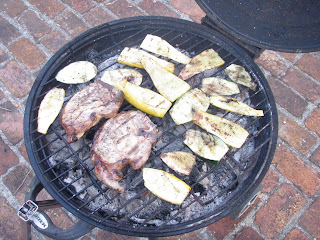The Fourth of July is coming and what to cook? I am grilling
some pork chops along with squash from the garden. I decided to work on some
new sides and since I have lots of green beans (Louisiana Purple Pod) I could
not refuse to use them as a major side dish. Also along with the beans our
tomatoes are in so I thought I would add some okra and corn to make another
tasty side dish. (My okra and corn are a little late but others are in and you
can find all in the markets.)
Using my new cookbook from Charleston from the Lee Brothers,
I have been doing their really good green bean recipe. I have probably done it
five times already (I’ve got lots of green beans!), but it is easy and uses
bacon which reminds me of my mother’s green bean recipe
Both recipes are from The
Lee Bros. Charleston Kitchen, 2013.
Long-Cooked Green Beans
Makes 8 servings
Time: 1 hour and 45
minutes
½ pound smoked slab bacon or smoked sausage, sliced
2 pounds green beans, stems trimmed, cut into 2-to3-inch
lengths
Kosher salt and freshly ground black pepper
¼ to ½ teaspoon red pepper flakes
1 tablespoon cider vinegar
2 tablespoons unsalted butter
Bring 2 quarts of water to a simmer with the bacon in a
6-quart stockpot over high heat. Add the beans, and when the liquid returns to
simmer, turn the heat to low, and cook uncovered for 30 minutes.
Add 1 tablespoon salt, 1 teaspoon black pepper, the red
pepper flakes, and vinegar. Cover and simmer on low for 45 minutes (you should
be left with just 1 ½ to 2 cups broth; if the beans appear to be boiling dry,
add water as necessary by half cups).
Season to taste with salt, and add the butter, stirring to
melt, before serving.
Serve the beans warm and slightly soupy.
Pan-Roasted Okra, Corn, and Tomatoes
Serves: 6
Time: 45 minutes
3 tablespoons vegetable oil, plus more for brushing
8 ounces fresh okra, halved lengthwise
Kosher salt
1 ½ cups corn kernels (from 2 large ears)
2 pounds fresh tomatoes
2 ounces slab bacon, cut into large dice
1 medium white onion, chopped (3/4 cup)
1 large garlic clove, mashed to a paste
1 to 2 teaspoon vinegar, either red wine, white wine, or
distilled white (optional)
Freshly ground black pepper
Heat a large cast-iron skillet over high heat until very hot
and brush lightly with vegetable oil. In a bowl, toss the okra with 1
tablespoon of the oil and season with ¼ teaspoon salt. Cook the okra in the pan
in two batches, turning once, until charred and tender, 3 to 4 minutes per
batch depending on the size and freshness of your okra .Reserve in a bowl so
you can reuse the cast-iron skillet.
Add 1 tablespoon of the oil to the corn and season with ¼
teaspoon of the salt. Add the corn to the skillet and cook over high heat,
stirring occasionally, until lightly charred in spots, about 3 minutes. Reserve
the corn in a bowl, separate from the okra.
Bring a large saucepan of water to a boil and fill a bowl
with ice water. Score the tomato bottoms with an X. Add the tomatoes to the
boiling water and blanch for 10 seconds to loosen their skins. Transfer the
tomatoes to the ice water to cool. Core and peel the tomatoes, and halve them
crosswise. Working over a sieve set in a bowl, tease out the seeds with your
fingers. Press on the seeds to extract the juice, then discard them. Chop the tomatoes
and reserve them in the bowl of their juice.
Pour the remaining tablespoon oil into the skillet over
medium-high heat, and when it simmers, add the bacon. Sauté the bacon until it
just begins to brown, about 4 minutes, then add the onion and ½ teaspoon salt.
Stir continuously for about 2 minutes, allowing the onion to release some
moisture, but not letting it brown. Add the garlic and cook for about a minute
to let its flavor bloom (do not brown the garlic). Then add the tomatoes, and
stir to combine. Cover the pot, reduce the heat to medium, and cook for about 4
minutes until the tomatoes have mostly collapsed.
Add the corn, stir to combine, and cook for 3 more minutes.
Add the okra, stir, and cook just until the okra is heated through, about 2
minutes. Season to taste with the vinegar (which you may or may not need,
depending upon the acidity of the tomatoes), salt, and black pepper; serve.
Happy 4th of July!









